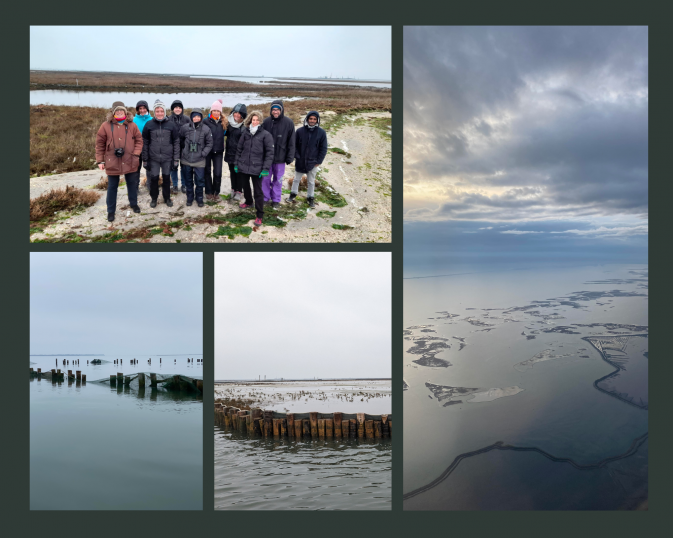
Photo of the Venice Lagoon site and team
Venice Lagoon: an insight into the current state and future goals of the Pilot Site
The Venice lagoon is the largest lagoon in the Mediterranean region, 550 km2, providing a broad range of ecosystem services and facing several management challenges (Rova et al., 2019; Rova et al., 2022). The lagoon is a complex mosaic of coastal habitats including saltmarshes, seagrasses, wetlands, mudflats, islands, and eutrophic lakes (Ravera, 2000; Rova et al., 2019; Solidoro et al., 2010), displaying unique ecological characteristics (Taramelli et al., 2021). It is a good example of a social-ecological system as the morphology and ecology of the lagoon have been deeply influence by human interventions since the 15th century (D'Alpaos & D'Alpaos, 2021; Rova et al., 2019; Solidoro et al., 2010), consequently the lagoon is progressively losing its original form (D'Alpaos et al., 2010).
During the last century, the Venice lagoon has experienced general tidal form degradation including the deepening of tidal flats and the reduction of salt marshes (Carniello et al., 2009). The diversion of the rivers reversed the problems related to the silting up of the lagoon into erosion problems affecting the lagoon morphologies (Carniello et al., 2009; D'Alpaos & D'Alpaos, 2021). The subsequential salt marsh regression was sped up during the last century following the excavation of deep canals for the passage of large cargo ships and the construction of the jetties at the three inlets (Carniello et al., 2009). At present 5 to 10% of the lagoon is covered with the surviving salt marshes (Carniello et al., 2009), representing a reduction of 137 km2 since 1810 (D'Alpaos & D'Alpaos, 2021; da Mosto et al., 2020). This morphological degradation threatens the lagoon biodiversity and halts the provisioning of ecosystem services that are of fundamental importance to human well-being, health, livelihood, and survival (D'Alpaos & D'Alpaos, 2021).
Since the 1990s, several salt marsh restoration efforts have been carried out under the “Piano Morfologico e Ambientale della Laguna di Venezia” (Taramelli et al., 2021), based on historical analysis of the morphological changes and hydraulic optimisation (Tagliapietra et al., 2018). The salt marsh restoration follows a pragmatic two steps approach:
- the creation of a containment barrier along the perimeter, designed based on the features of the environment to be created, and
- pumping fluidised mud, dredged from the lagoon channels to restore water circulation and allow navigation, until the desired height (Tagliapietra et al., 2018).
In January 2023 the Venice pilot partners visited the pilot site, to assess the current state of the eight salt marshes prior to a new restoration and establish the locations for the upcoming monitoring activities for the REST-COAST project. It was clear that some of the containment barriers of the salt marshes (restored in the past between 1989 and 2017) had degraded and that sediment had been lost, as can be seen in the picture. In the spring of 2023 restoration activities will start, and within our pilot we will study how the restoration helps improve morph-dynamic function, diversity, and ecosystem service provisioning in the Venice lagoon.
The Venice Lagoon team